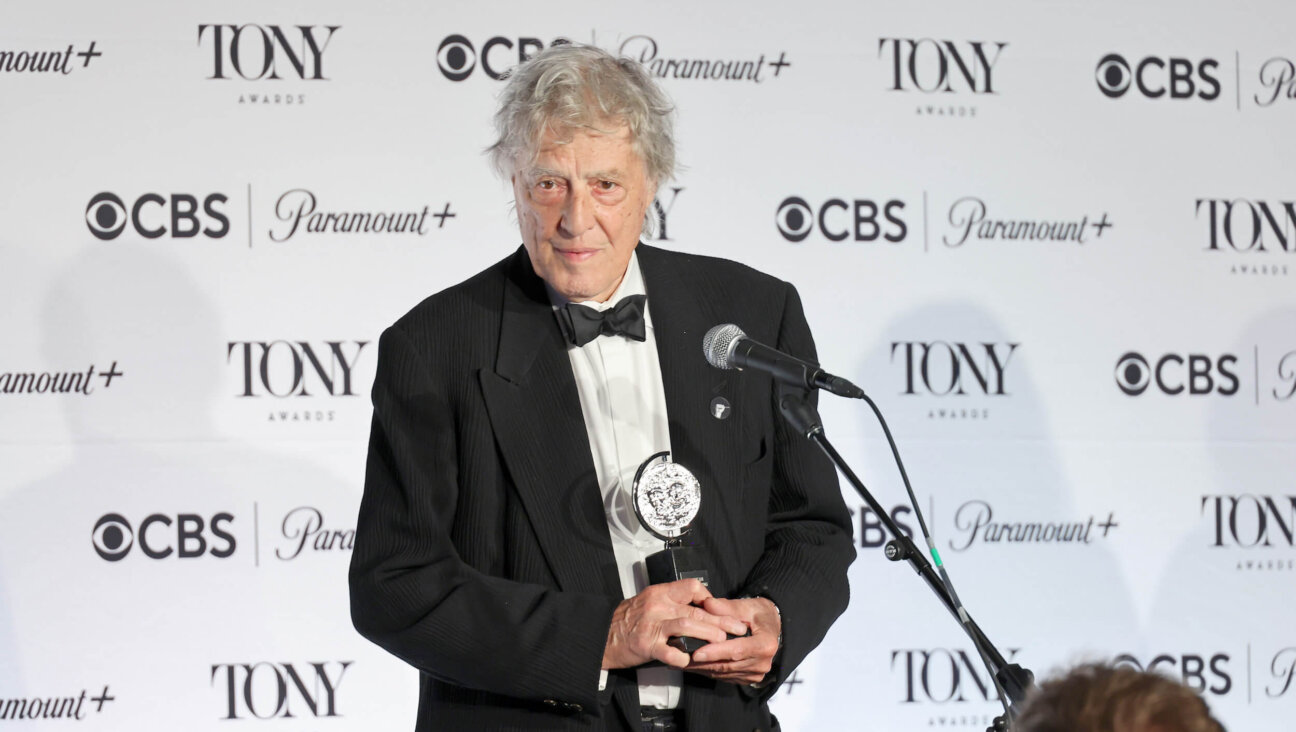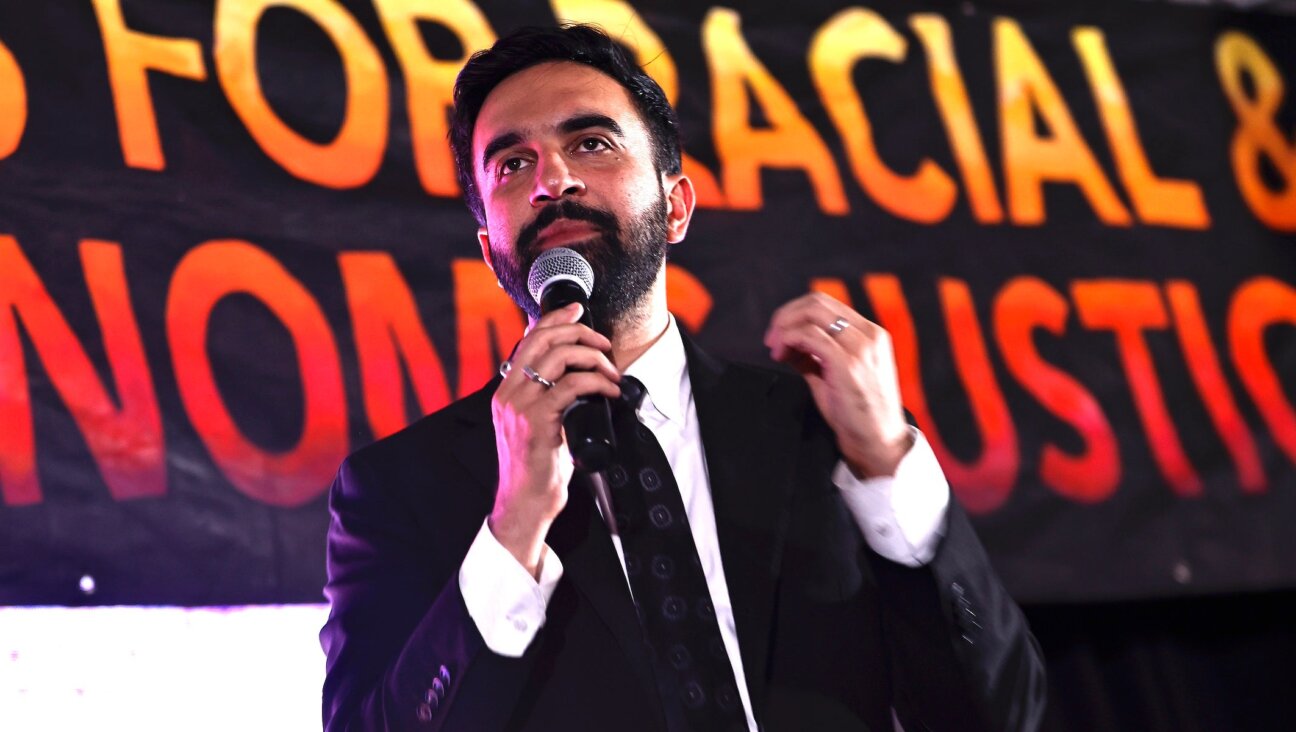Before the ‘Big Bang’ With Mayim Bialik

Graphic by Angelie Zaslavsky
Getty Images
Mayim Bialik, 38, is part neuroscientist, part actress, part superhero and 100% Jewish Renaissance woman. Known for her starring role on the CBS comedy “The Big Bang Theory,” she’s been nominated for Emmy and Screen Actors Guild awards. What fans may not know is that her experience as a neurobiologist is not limited to TV; she earned a doctorate from University of California, Los Angeles after majoring in neuroscience with a minor in Jewish studies and Hebrew. Bialik was also a leader at UCLA Hillel.
This wonder woman grew up in Southern California. At 12 she played sassy, cigarette-smoking younger CC Bloom, Bette Midler’s character in the 1988 movie “Beaches,” then landed a starring role in the popular ’90s sitcom “Blossom.” She’s written two books, is the mother of two children, writes for the Jewish parenting blog Kveller and takes being a role model for young girls very seriously. The Forward’s Dorri Olds caught up with Bialik to talk about her acting, tzniut [Jewish laws of modesty] and her work to empower young girls.
Dorri Olds: Can you tell me about your new book?
Mayim Bialik: It’s a cookbook, “Mayim’s Vegan Table: More than 100 Great-Tasting and Healthy Recipes From My Family to Yours,” which actually started with me sharing recipes on the Jewish blog that I write for, titled Kveller. I wrote the book with Dr. Jay Gordon, a pediatric nutritionist. It’s basically the 100 recipes that I make most often for my kids.
What are you teaching your children about Judaism?
I resonate with the philosophy and principles of Modern Orthodoxy even though I don’t live a life, or have a career, that makes it possible for me to be a poster person for Modern Orthodoxy or any kind of Orthodoxy.
What do you mean?
I hold to the standards of tzniut in that even on the red carpet I don’t wear anything that shows the knee, I don’t wear plunging necklines, I don’t wear sleeveless and I don’t wear strapless, but tzniut is not just about what you wear; it’s how you carry yourself. Men and women follow guidelines of modesty.
Did you really go back to acting for to obtain health insurance, or was that a joke?
Not a joke. I taught for five years and I was running out of health insurance, and figured if I could audition here and there and maybe get a couple of parts, I could get health insurance again. I was not planning to be a regular on a TV show. That was not at all something that I thought was going to happen. It really surprised me, and my ex, as well. I’m very grateful, but that was not the plan.
Do you read reviews?
No, I don’t read anything about me, not even comments on Facebook. I write my own Facebook and Twitter pages, but it’s too demoralizing and too upsetting to read any comments or reviews. I don’t Google myself. Nothing. There’s a lot of inappropriate and crazy stuff out there, so I just stay away.
Do you work on the TV show for seven hours and then go home?
When we work, it’s five days; some are rehearsal days and some are tape days. The hours vary. I work during school hours most days of the week, and then when we tape it’s a 12-hour day.
How would you describe yourself?
I’m not a very confident person.
Do you feel comfortable when you’re on set?
Sure. I mean I’m sort of an awkward person in general, but yeah, I love my job and I love who I work with.
What types of insecurities do you have?
I’m a pretty insecure person. I’m a people pleaser. I second-guess myself and have a hard time making decisions. Even in my parenting, especially with my first son, I was nervous that I was doing things wrong. I was easily influenced by other people’s criticisms, but I think I’ve gotten better about that.
Speaking of parenting, can we talk about your first book?
Sure, it’s titled “Beyond the Sling: A Real-Life Guide to Raising Confident, Loving Children the Attachment Parenting Way.”
How did your belief in and practice of attachment parenting begin?
I was in grad school and a couple friends were practicing attachment parenting, which includes natural birth, breastfeeding, carrying your baby on your body and sleeping in the same bed with your child. It was like they were obsessed with their children, but as their kids got older a few things struck me: The parents didn’t use any force or violence, didn’t threaten timeouts or put their kids in the corner and didn’t yell. Their children were very pleasant to be around and seemed communicative and sensitive. At the time, I was studying the hormones of human bonding, and what I was seeing was consistent with what scientifically is true: We are made with hormones that allow us to birth, breastfeed and regulate our baby’s temperament by being close to [our children].
How did you and your husband manage co-sleeping?
People do it all different ways. Some people have one large family bed. We slept in two mattresses next to each other in different combinations, depending on who wanted to sleep where on any given night. Some parents do attachment parenting without sleeping with their kids. It really depends. It’s not like you have to co-sleep to be considered an attachment parent.
When parents are sleeping with their children, how can the couple have sex?
People find ways to have sex — in other places and at other times. Thousands of people safely sleep with children and still have very happy sex lives and happy marriages. For all of history, people have slept with their children either within the same bed or in the same room. It really has nothing to do with sex. The decisions that couples make about where and when to have sex have a lot more to do with the relationship than who they sleep with.
Now lets talk about Texas Instrument’s STEM Behind Hollywood. First, what does STEM stand for?
Science, Technology, Engineering and Mathematics. I’ve been the spokesperson for Texas Instruments for three years now. One of the programs they designed is a set of free and downloadable learning tools and lessons that can be used on a tablet or on the TI-Nspire, the graphic handheld calculator that TI uses. The “STEM Behind Hollywood” program uses subjects that kids are interested in because they’re part of popular media, like zombies, superheroes, forensics and space. With zombies we teach everything from epidemiology, structures in the brain, how to manage disease and the exponential growth curve in disease. There are real math and science lessons and models that you can choose, and it appeals to kids because they see it in popular culture. It’s a really neat set of programs.
What is your project with DeVry University?
I am a spokesperson for DeVry University’s “HerWorld,” whose focus is to empower high school girls to explore careers in STEM. The platform that I speak from for both Texas Instruments and DeVry University is that the STEM information should be presented to girls as equally as [they are IT IS] to boys. We need to find different ways to present it to engage girls. There’s no reason that girls can’t and shouldn’t pursue those fields.
A couple of more questions: What is the most fun thing about being famous?
Being in a position to use fame for good and not just for pleasure. The work that I do with Texas Instruments and also with DeVry University is extremely rewarding in that I can use my fame to make an impact, especially for young girls by encouraging STEM education.
And what is the hardest thing about being famous?
You live your life in a goldfish bowl. Nothing is anonymous about you unless you work very hard to make it so. If I do something with my sons, anywhere I go with them, that’s open to people recognizing me. People videotape me with their iPhones when I’m not looking. I went to the supermarket, and someone thought it was in their right to videotape me checking out at the supermarket counter. That’s fascinating to me. I don’t know what’s so interesting about me buying my groceries.
This interview has been edited for style and length.
















